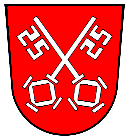Regensburg
|
|
| Coat of Arms | Map |
|---|---|

| 
|
Regensburg (English formerly Ratisbon, Latin Ratisbona, Czech Řezno) is a city (population 146,824 in 2002) in Bavaria, south-east Germany, located at the confluence of the Danube and Regen rivers, at the northernmost bend in the Danube. To the east lies the Bavarian Forest. Regensburg is the capital of the Bavarian administrative region Upper Palatinate.
| Contents |
History
The first settlements in Regensburg date to the Stone Ages. The Celtic name Radasbona was the oldest name given to a settlement near the present city. Around AD 90 the Romans built a small "cohort-fort" in what would now be the suburbs.
In 179 the Roman fort Castra Regina ("fortress by the river Regen") was built for Legio III Italica during the reign of Emperor Marcus Aurelius. It was an important camp on what was then the northern fringe of the empire. It is believed that even in late Roman times it was the seat of a bishop, and St. Boniface re-established a bishopric there in 739.
From about 530 to the first half of the 13th century, it was the capital of Bavaria. Throughout the early Middle Ages, Regensburg was the cultural center of southern Germany and was celebrated for gold work and fabrics. In 1245, it became a Imperial Free City and was a trade center before the shifting of trade routes in the late Middle Ages.
It adopted the Reformation and its Town Council remained entirely Lutheran until the incorporation of the city into Bavaria. Nonetheless, the majority of the population soon became (or remained?) Catholic. This was helped by the continued existence of the Cathedral and a couple of abbeys, as well as immigration from the largely Catholic surrounding districts.
From 1663 to 1806, it was the permanent seat of the Reichstag (Imperial Diet) of the Holy Roman Empire. In 1809, the city was partially destroyed by the French under Napoleon, with the Holy Roman Empire dissolving in the process. A year later Napoleon formed the Kingdom of Bavaria, with Regensburg becoming a part of it.
Between April 19 and April 23, 1809 Regensburg was the scene of the Battle of Ratisbon between forces commanded by Baron de Coutaud (the 65th Ligne) and retreating Austrian forces. It was eventually overrun after supplies and ammunition ran out.
Buildings
Regensburg_cathedral.jpg
The cathedral, though small, is a very interesting example of pure German Gothic. It was founded in 1275, and completed in 1634, with the exception of the towers, which were finished in 1869. The interior contains numerous interesting monuments, including one of Peter Vischers masterpieces. Adjoining the cloisters are two chapels of earlier date than the cathedral itself, one of which, known as the old cathedral, goes back perhaps to the 8th century. The church of St James also called Schottenkirche a plain Romanesque basilica of the 12th century, derives its name from the monastery of Irish Benedictines (Scoti) to which it was attached; the principal doorway is covered with very singular grotesque carvings. The old parish church of St Ulrich is a good example of the Transition style of the 13th century, and contains a valuable antiquarian collection. Examples of the Romanesque basilica style are the church of Obermünster, dating from 1010, and the abbey church of St Emmeran, built in the 13th century, and remarkable as one of the few German churches with a detached belfry. The beautiful cloisters of the ancient abbey, one of the oldest in Germany, are still in fair preservation. In 1809 the conventual buildings were converted into a palace for the prince of Thurn and Taxis, hereditary postmaster-general of the Holy Roman Empire. The town hall, dating in part from the 14th century, contains the rooms occupied by the imperial diet from 1663 to 1806. An historical interest also attaches to the Gasthof zum Goldenen Kreuz (Golden Cross Inn), where Charles V. made the acquaintance of Barbara Blomberg, the mother of Don John of Austria (born 1547). The house is also shown where Kepler died in 1630. Perhaps the most pleasing modern building in the city is the Gothic villa of the king of Bavaria on the bank of the Danube. At Kumpfmühl, in the immediate neighbourhood of the city, was discovered, in 1885, the remains of a Roman camp with an arched gateway; the latter, known as the Porta Praetoria, was cleared in 1887. Among the public institutions of the city should be mentioned the public library, picture gallery, botanical garden, and the institute for the making of stained glass. The educational establishments include two gymnasia, an episcopal clerical seminary, a seminary for boys and a school of church music. Among the chief manufactures are iron and steel wares, pottery, parquet flooring, tobacco, and lead pencils. Boat-building is also prosecuted, and a brisk transit trade is carried on in salt, grain and timber.
Near Regensburg are two very handsome classical buildings, erected by Louis I. of Bavaria as national monuments of German patriotism and greatness. The more imposing of the two is the Walhalla, a costly reproduction of the Parthenon, erected as a Teutonic temple of fame on a hill rising from the Danube at Donaustauf, 6 miles to the east. The interior, which is as rich as coloured marbles, gilding, and sculptures can make it, contains the busts of more than a hundred German worthies. The second of King Louis' buildings is the Befreiungshalle at Kelheim, 14 miles above Regensburg, a large circular building which has for its aim the glorification of the heroes of the 1813 War of Liberation.
See also
Partner Cities
- Aberdeen, Scotland (United Kingdom), since 1955
- Brixen (Bressanone), (Italy), since 1969
- Clermont-Ferrand (France), since 1969
- Pilsen (Czech Republic), since 1993
- Tempe, Arizona (USA), since 1981
- Odessa (Ukraine), since 1990
External links
- City web site (in German with international pages) (http://www.regensburg.de/)
- University web site (http://www.uni-regensburg.de/)
es:Ratisbona fr:Ratisbonne it:Ratisbona nl:Regensburg ja:レーゲンスブルク no:Regensburg pl:Ratyzbona pt:Regensburgo sv:Regensburg


